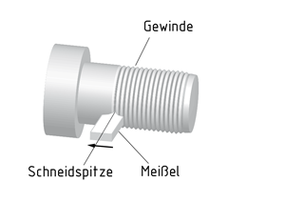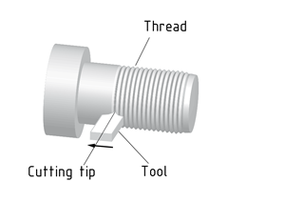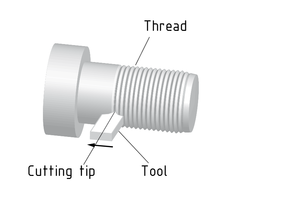
Wählen Sie eine
oder mehrere Sprachen aus
0,1,0
- Deutsch
- Englisch
- Chinesisch
- Spanisch
Gewindedrehen

Beim Gewindedrehen, einem Schraubdrehverfahren, können mit Gewindedrehmeißeln Außen- und Innengewinde hergestellt werden. Das Profil des Meißels (Schaftprofil-, Rundprofil-, hinterdrehende Rundprofilmeißel) und seine Positionierung müssen entsprechend der gewünschten Gewindeform gewählt werden. Bei der mehrstufigen Gewindefertigung wird das Werkzeug mehrfach an gleicher Stelle des Werkstück-Umfanges angesetzt.
Eine Leitspindel sorgt auf Universaldrehmaschinen für die Vorschubbewegung, die über Vorschubkurven, Leitpatronen oder numerische Steuerungen eingeleitet wird. Dabei muss der Vorschub der Gewindesteigung entsprechen, so dass der Meißel das gewünschte Profil hinterlässt. Beim Drehen von Rechtsgewinden wird das Werkzeug bei rechtsdrehender Arbeitsspindel vor die Drehmitte gespannt, für linksdrehende Gewinde müssen Drehrichtung und Einspannlage entsprechend geändert werden. Wichtig sind die präzise Einstellung der Schneidenspitze auf die Drehmitte und die rechtwinklige Zustellung der Drehachse.
Thread turning

The process of thread Turning involves the use of tools to produce male and female threads. The profile (shank profile tool, round profile tool, back-turning round profile tool) and positioning of the tool must be selected according to the desired thread Design. During multi-stage thread production, the tool is applied several times to the same point of the workpiece circumference.
On universal lathes, a lead screw supplies the feed motion, which is initiated via e.g. feed cams, chasers or numerical controls. In doing so, the feed must correspond to the thread pitch so that the tool creates the desired profile. When turning right-hand threads, the tool is clamped ahead of the Rotation centre in the case of clockwise spindles
螺纹车削

螺纹车削工艺是指使用刀具生产外螺纹和内螺纹。刀具的轮廓(柄形轮廓车刀,圆形轮廓车刀,反刀圆形轮廓车刀)和定位必须根据所需螺纹的造型来选择。在多级螺纹的生产过程中,刀具被几次施加到工件圆周的同一工位上。
使用万能车床时,丝杠提供进给运动,通过如进刀凸轮,螺纹梳刀或数字控制实现。这样做时,进给必须对应螺距以制造所需的轮廓。车削右旋螺纹时,刀具夹紧在顺时旋转轴中心的前方;车削左旋螺纹时,必须改变旋转方向和夹紧位置。关键要素是精确调整割嘴相对于旋转中心的位置,以旋转轴 90°方向进刀。
螺纹车削的原理
Giro de rosca

El proceso de giro de rosca involucra el uso de herramientas para producir roscas hembras y machos. El perfil (herramienta de perfil de fuste, herramienta de perfil redondo, herramienta de perfil redondo de contragiro) y el posicionamiento de la herramienta deben ser seleccionados de acuerdo con el diseño de rosca deseado. Durante la producción de rosca de etapas múltiples, la herramienta es aplicada varias veces al mismo punto de la circunferencia de la pieza de trabajo.
En tornos universales, un tornillo guía suministra el movimiento de alimentación, el cual es iniciado mediante, por ejemplo, levas de alimentación, cinceladores y controles numéricos. Al hacer esto, la alimentación debe corresponder a la inclinación de la rosca de manera que la herramienta cree el perfil deseado. Cuando se giran roscas derechas, la herramienta es sujetada adelante del centro de rotación en el caso de husillos que funcionan en el sentido de las manecillas del reloj; la dirección de rotación y el punto de sujeción deben cambiar para las roscas izquierdas. Los elementos clave son el ajuste preciso de la punta de corte en relación con el centro de rotación y la alimentación a 90° del eje de rotación.
Principio de giro de rosca
